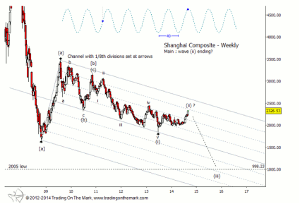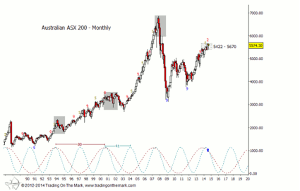The staff at Trading On The Mark takes a technical look at the Australian and Chinese stock indices, shares their outlook of a possible major downward reversal in the near future, and outlines how traders should prepare for one.
With Australia's and China's economies so closely linked, how likely is it that the stock markets in both nations can continue moving in opposite directions? In this article, we draw on excerpts from our recently published e-book to compare the major stock indices of each nation, and we note some factors that suggest both indices are on the verge of reconciling their divergence.
China is Australia's biggest trading partner, with valuation of trade that match the entirety of the island continent's trade with Japan and the United States combined. As with most of China's trading relationships, natural resource feedstocks dominate its imports from Australia, and consumer goods are the largest part of its reciprocal exports. However, despite those close ties, Australia's ASX 200 Index has rallied since 2009 while China's Shanghai Composite Index has declined over the same period.
Looking forward, we believe the big-picture decline in the Shanghai index is likely to continue, with a downward turn due soon. That should correspond with a major downward reversal in the Australia index. This conclusion is based on a combination of Elliott wave analysis and cycles analysis, as described below.
The Shanghai Composite Index, China’s broadest equity index, has been declining for several years already. The spectacular crash in the Shanghai Composite in 2007 and 2008 coincided with the decline in stock indices worldwide. Although the Shanghai Composite participated in the global stock rally from late 2008, it failed to keep up with other indices in subsequent years. Instead, it has taken a sideways-down path to visit prices not far from its 2008 low. We believe it has a considerable distance yet to fall.
We admit it was difficult to assign an Elliott wave count to the decline from 2009. There have been several overlapping moves, and many of the sub-moves have a corrective look. Based on recent developments, we believe that price is tracing a downward impulsive [c] wave that began in late 2010. Note in particular how well price has behaved within the modified Schiff channel when it is anchored to the main waves corresponding to that Elliott wave count.
In this interpretation, the Shanghai index currently is pressing against important resistance in the form of the channel midline, and the dominant 44-week cycle in price is on the verge of turning downward.
At this point, we believe price should eventually fall below the 2005 low of 998.23, although we will continue monitoring that assessment during the next 12 to 24 months.
The S&P/ASX 200 Index reflects the top 200 stocks in the Australian Securities Exchange. On the monthly timeframe, two cycles can be extracted from price data, with lengths of 80 months and 41 months. This summer, both of those cycles have begun moving into their downward phases. Based on cycles alone, we would expect weakness to extend into 2016 or 2017. The shaded areas on the monthly chart below show previous times when both cycles have converged in their downward phases and each instance has coincided with either a retrace or a reversal.
In addition, we see that the Wave59 "nine-five" exhaustion indicator has registered a "5" exhaustion signal recently, coinciding with price having moved into a long-term target area of 5,422 to 5,670, as shown with the crosshatched box on the chart.
Initial confirmation of a downward turn in the ASX 200 would come in the form of a weekly close below the support implied by the center line of the channel on a weekly chart, or approximately 5,520 by late September.
By the staff at Trading On The Mark























